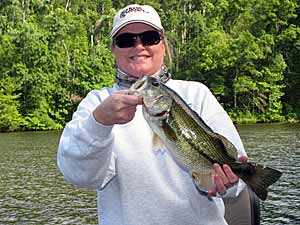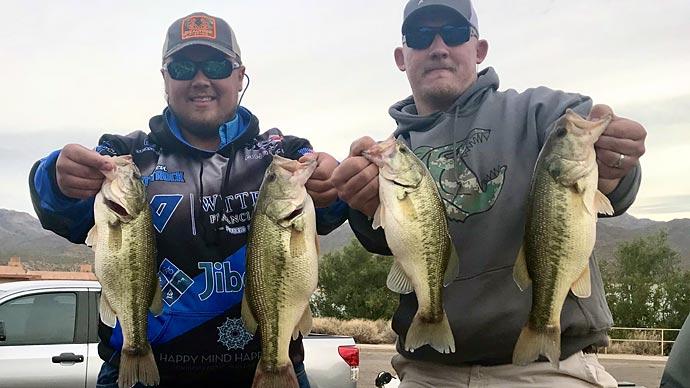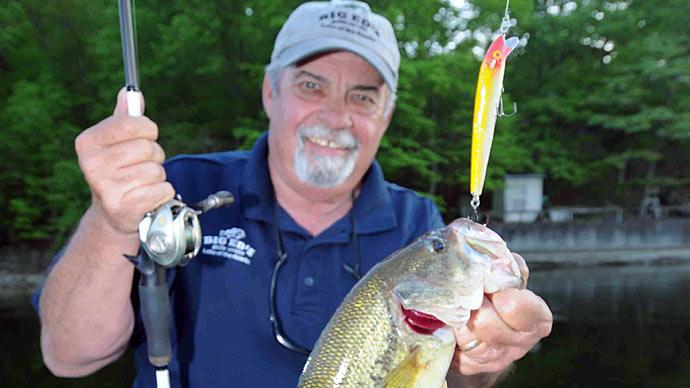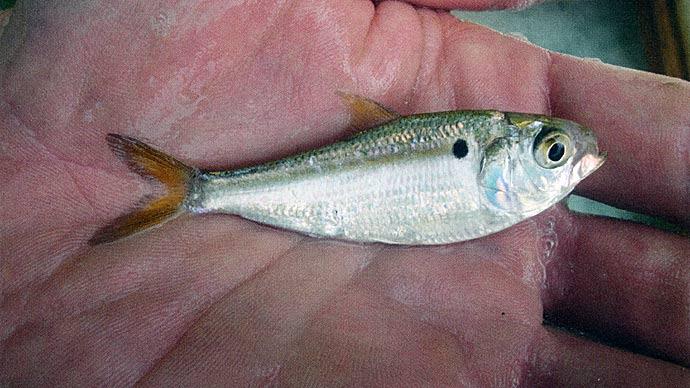
Selective harvest may not be the subject of many suppertime conversations, unless you happen to be eating a cornmeal crusted yearling bass wrestled from your lake moments ago.
So, let's tackle the topic from a real-life lake and real-life lake manager. How significant is selective harvest? Just ask Dr. Jim Geisler.
He owns a 30-acre lake nestled in gorgeous pine and hardwood forests northwest of Monroe, LA. The adjacent habitat is bustling with wildlife.
Wild turkey gobbles echo through the woods at the same time a giant bass chasing breakfast slaps its tail on the water's surface. Whitetail deer meander through dense woods, protected by forest canopy and diligent management of an earnest land steward.
The lake itself teems with aquatic life. Giant bass, huge bluegills, young fish, schools of shad, bugs, plankton, vegetation. Forrest Gump may think "it" happens, but Dr. Geisler would argue otherwise. "It" doesn't just "happen."
The 73-year-old pathologist under the ever-present pith helmet plays pond management perfectly. His favorite techniques - fertilization, vegetation, selective harvest, supplemental stocking, genetics - are classic tools used by pondmeisters coast to coast. Geisler leaves little to chance.
"Without selectively harvesting young bass, this lake would have reached a peak years ago, and then deteriorated," Dr. Geisler said. "We use all the different techniques good pond managers use. If we didn't, I suspect we would have a clear lake, lots of small bass, and too much aquatic plant growth."
Hear, hear! Ever seen a clear lake, lots of small bass, and too much aquatic greenery? Here's the story of Geisler's pet project:
About 18 years ago, Dr. Geisler contacted the Soil Conservation Service, now called the Natural Resources and Conservation Service, to assist in deciding whether to build a lake. Technicians brought out an auger, drilled several 7-foot deep test holes, all filled with sand.
Not good news.
Sand doesn't hold water. Neither did the prospect of walking away from such a promising project. Three tributaries draining forested land merged into a nice creek, and a short dam could create a lake shaped like a chicken's foot.
Dr. Geisler thought about it and literally dug deeper into the subject. He called the SCS office, asked why holes were only drilled to seven feet. Simple question, simpler answer. That's how long the auger was.
Enter a contractor with a backhoe.
The persistent pathologist found good beds of clay at 12 feet. So they removed 12 feet of sand, dug a core trench five feet deep into the clay bank, then used perfect clay soils to backfill the trench, and create the front slope of the dam. See a pattern developing here? Relentless pursuit leads to an abundance of clay, which is shaped into a solid dam. Which becomes a scenic, healthy body of water.
There should have been plenty of water available to fill the lake, but something was amiss. After all, the lake holds like Dolly Parton's bra.
A pipe installed through the dam quit flowing. Water backed up, dirt work stopped, heads were scratched. There was no logical reason. A valve on the backside was open, but water flowed at a trickle. Puzsled, one of Geisler's scuba diving friends donned a wet suit, and investigated.
Seconds went by and the young diver emerged from the 10-foot water and exploded to the surface, wide-eyed, like a kid at a monster movie. A huge loggerhead snapping turtle had been sucked partially into the 8-inch pipe, and was lodged.
Valve shut, turtle pulled out, lake drained, work restarted.
The newly filled lake was stocked with tiny bluegill and "chinquapin" perch (redear sunfish or "shellcracker" to those of us outside Louisiana), and shortly thereafter, Florida-strain largemouth bass.
"I didn't know anything about managing a lake or fish," a smiling Dr. Geisler quipped, "but I knew bass needed something to eat, so we stocked a food chain first."
"And, as luck happened, we were also able to get pure strain Florida bass from a nearby state fish hatchery."
Talk about luck. That was the first year Louisiana hatcheries had pure-strain Florida bass available for public stockings, and the last year they stocked private lakes.
"I didn't know anything about limits, or how to selectively harvest young bass, to keep the fishery in balance." After two years, Geisler caught a four pound bass. The next year, an 8- pounder was brought in the boat. Fast growth, indeed. But, there are consequences to fast growth of young bass.
It probably meant there weren't many bass in the beginning. The next few years proved the theory.
Small bass quickly dominated the landscape, results of successful spawns and too few predators to eat baby bass. Of course, big bass were occasionally caught, but the system became log-jammed with 10-14" bass by the fourth year.
That's when Dr. Geisler sought professional help.
He has brought in a professional biologist each year for the last 13 years. A survey may confirm what he already knew, but there's been plenty of years of surprises, too. Nine years ago, the lake was overcrowded with 10-12" bass, so a slot limited was started. Dr. Geisler is picky with his fishermen friends. They play by his rules, or they don't play.
Weighing and measuring bass is huge. From time to time, during the year, Geisler has fishermen weigh and measure every bass caught. From that data, he tracks bass growth for the year. Bass growth fluctuates, as does forage fish numbers.
That's where Prevois Gibson comes in. "Poly," as he is affectionately called, has been Geisler's right-hand man for 15 years. It's Poly's job to make sure the lake is fertile, has plenty of cover, and to do all the other jobs around the property that need to be done. He fills feeders, chops brush, and knows the land and lake better than anyone.
Poly fertilizes at the right time, reads the bloom, and tweaks the lake as needed. Fertile water is critical during spawn. Baby fish, all species, are hatched, tiny little creatures with tiny mouths. Plankton feeds baby fish that might otherwise starve to death.
The food chain grows, feeding the small bugs that feed bigger bugs that feed small fish that feed bigger fish. You know the routine.
But, even with perfect plankton blooms in fertile water, perfect genetics to complement dynamics of fish growth, a fishery won't stay balanced unless fish are harvested.
During the most recent electro-fishing survey, May 23, 50 largemouth were collected, and lots more were observed, and left in the lake. Fish ranged in size front brand new young of the year to one bass tipping the scales at a whopping 13 pounds.
Of those 50 largemouth, 20 weighed 2-4 pounds. Two were larger than five, along with the monster bass. Eleven weighed between one and two pounds. Remaining bass were 5-9 inches, from a late winter, early spring hatch. And, there were four schools of tiny bass, with 10,000-15,000 in each school, probably less than two weeks old.
This data indicates the bass fishery is balanced. Fish of different size ranges, with healthy weights. Each fish was 95-105 percent of what relative weights should be. Excellent.
Bluegill were plentiful, and ranged in sizes from babies to 14", nearly a pound and a half. The fishery is in balance, with young fish ready to take the place of bigger bass, as those grow into larger sizes. Selective harvest plays a major role.
"Last year we were supposed to take up to 200 14-16 inch bass from the lake. We took around a hundred, that I have record of," Geisler said.
"It looks as though by reducing numbers of mid-size bass, competition for food isn't as intense, and all the fish are able to grow."
He's so right. By culling those 100 bass, or 3 per acre, Geisler's lake continues to produce enough forage fish for all. 100 doesn't sound like many bass for a thirty acre lake, but his slot limit has been in place for several years. Cumulatively, there have probably been close to 1,000 bass harvested. Selectively, that is.
Geisler's goal for his hideaway paradise is to be able to catch plenty of two to four pounders, but an occasional trophy bass is a important touch.
"Over the years we have had several double-digit bass caught and released," he said with a chuckle. "One fish pegged my scale. My scale weighs to 12 pounds, and I know this bass was at least 1.5 to 2 pounds heavier."
To make this goal, Geisler knows bass must be harvested. To that end, the slot limit changes, as the fish population changes. The survey, and fishermen's catch records tell the tale. If a particular size range of bass dominates the statistics, and are beginning to lose weight, those are the fish targeted for slot limit harvest.
Each spring Poly fertilizes. Baby fish grow, vegetation is held in check. Shad spawn, school, bass chase them. Coppernose bluegill spawn 3-4 times a year, bass chase them. The cycle of food expands, contracts, ebbs and flows. Bass grow, some fast, some slow. Things change, and Dr. Geisfer is light enough on his feet to change with the fishery. That's part of his fun.
For all the variables of nature, there are two constants at Geisler's lake - selective harvest by slot limit, and Poly's work ethic in monitoring this special lake.
Besides, it's smart fisheries management.
Reprinted with permission from Pond Boss Magazine



